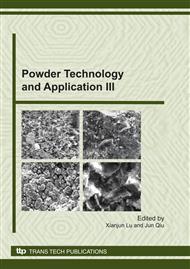p.233
p.241
p.248
p.256
p.262
p.273
p.281
p.287
p.298
Synthesis of LiNi1/3Co1/3Mn1/3O2 Composite Powders by Solid State Reaction
Abstract:
A mixture of Li2CO3, NiO, Co2O3 and MnO2 with a molar ratio was introduced in the mixed high energy ball milling, LiNi1/3Co1/3Mn1/3O2 was prepared by solid state phase using mechanochemical activation which has highly reactive materials. The structure and electrochemical properties of LiNi1/3Co1/3Mn1/3O2 were analisised by employing X-ray diffraction(XRD), scanning electron microscopy(SEM) and galvanotactic charge-discharge test. Charge-discharge test results show that when the the LiNi1/3Co1/3Mn1/3O2 cathode was prepared by wet milling 10h between 2.8 V and 4.4V at a current of 0.5C rate, the initial discharge capacity is 135.1mAh/g, the capacity retention rate of 93.26% after 20 cycles. When nLi: n (Ni + Co + Mn) = 1.1, the samples sintered 20h at 850 °C, the first discharge capacity is 148.5 mAh/g, and the capacity retention rate is 94.88% after 40 cycles.
Info:
Periodical:
Pages:
262-272
Citation:
Online since:
November 2010
Authors:
Price:
Сopyright:
© 2011 Trans Tech Publications Ltd. All Rights Reserved
Share:
Citation:


